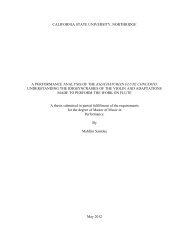2644 - CSUN ScholarWorks - California State University, Northridge
2644 - CSUN ScholarWorks - California State University, Northridge
2644 - CSUN ScholarWorks - California State University, Northridge
Create successful ePaper yourself
Turn your PDF publications into a flip-book with our unique Google optimized e-Paper software.
2750<br />
journal of Student Research Abstracts · 51<br />
DOES HYDROPONICS YIELD TALLER CORN PLANTS<br />
James A. Pong and Steve DeGusta (teacher). John F. Kennedy High School, 6715 Gloria Drive, Sacramento,<br />
CA 95931.<br />
For this investigation the heights of two groups of com plants, one grown in potting soil and the other grown<br />
hydroponically in vermiculite, were compared. All of the plants were grown from seeds in individual pots.<br />
Each group was comprised of twenty com kernels. For all the plants that grew, twenty in the hydroponics group<br />
and ten in the potting soil group, they were measured daily for a week. Each pot was watered with 3 ml of<br />
nutrient solution made from Miracle Grow every day. I thought that the hydroponics group would grow at a<br />
faster rate than the other group in the same period of time because a substrate, in this case the vermiculite contains<br />
no impurities or soil-borne pest like in soil or dirt. On the last day for recording data the plants in the soil<br />
had a greater average growth than the hydroponics group. By using statistics, I discovered that there was no<br />
significant growth difference between com plants grown in potting soil with plants grown in vermiculite<br />
(p>0.1).<br />
2751<br />
GROWTH INCREASE IN DUCKWEED DUE TO POTASSIUM PHOSPHATE.<br />
Cameron M. Pong and Steve DeGusta (teacher). John F. Kennedy High School, 6715 Gloria Drive,<br />
Sacramento, CA 95831.<br />
I hypothesized that potassium phosphate would increase the growth of the number of leaves in duckweed.<br />
I used a concentration of 0.04ppm (parts per million) of potassium phosphate in a 300ml solution of water as<br />
the experimental. I also grew a control group in 300rnl of water without the 0.04 concentration. Both groups<br />
contained 10 duckweed plants. The # of leaves for each plant was recorded and the growth over a two week<br />
period of time was compared between the two groups. Water was refilled daily to compensate for evaporation.<br />
The control group had a total growth of 5 leaves. The experimental had a total growth of one leaf. The difference<br />
in the two groups was compared using chi squared and was equal to 2.667. The p value from the chi<br />
squared calculation was between 0.2 and 0.05. The results from this were inconclusive. The results of the chi<br />
squared test neither rejected or accepted the null hypothesis, that the two groups were assumed to be the same<br />
with any difference due to chance. The p value was in the between range reject and accept so neither was applicable.<br />
The inconclusive p value was due to the lack of significant growth. Both groups did not grow as much<br />
as I had initially expected. I think that the lack of growth is due to the amount of light that the both groups<br />
were exposed to. Neither group had any light directly on them. The light that they got came from skylights and<br />
ceiling lights in the room.<br />
2752<br />
MEMORY AND MEMORY TRANSFER ABILITY OF PLANARIANS.<br />
Eric Ho and Steve DeGusta (teacher). John F. Kennedy High School, 6715 Gloria Drive, Sacramento, CA<br />
95831.<br />
This experiment began by testing whether or not planarians could be conditioned to always tum one direction<br />
when placed in a two-way maze. Five planarians were randomly chosen to do the maze. One at a time, a<br />
planarian was placed in the y-maze. When it reached the end one branch, it had to make a decision to go either<br />
left or right. I chose for them to go right. So every time it turned left, I delivered a negative stimulus in the<br />
form of an electric shock. A 6v battery hooked up to electrodes on the maze allowed me to do so. If planarians<br />
could in fact remember, then next time it should not want to go left and in tum go right. Each planarian<br />
ran the maze ten times a day for five days. There was a noticeable increase in the total number of right turns













